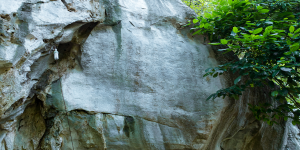
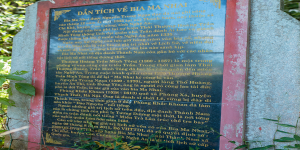
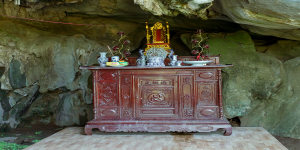
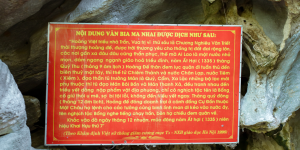
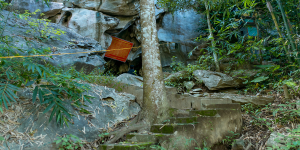

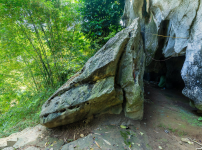
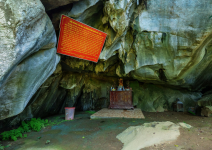
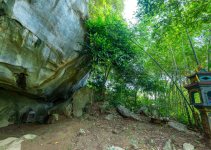

Camera tour
Price: Free
Time to visit a place: 120 phút
Open Time: 7:00 AM - Close Time: 6:00 PM
Address: Chi Khe Village, Con Cuong District, Nghe An Province
MA NHAI STELE
Located in a place with "charming scenery of mountains and rivers" in Chi Khe commune, Con Cuong district, Nghe An province, Ma Nhai stele is a unique historical relic left on the land of Nghe An carved into the mountain, dating from nearly 700 years ago (1335). The stele recorded the feats of the Tran Dynasty in preserving the territory, conquering foreign invaders, and recovering the lost land, demonstrating the prestige of the Dai Viet state in the cause of consolidating the nation's independence.
In the early years of the 14th century, under the Tran Dynasty, the diplomatic relations between Dai Viet and neighboring countries such as Ai Lao and Champa were complicated. Taking advantage of that situation, some tribes in the West, bordering Nghe An with the support of Ai Lao, have repeatedly invaded and plundered the people, making the people extremely miserable.
In order to show the strength of Dai Viet and at the same time to protect the territory and the people's life, in the Year of the Yi Pig, the the 7th year of Khai Huu era (1335) of the reign of King Tran Hien Tong, father of King Tran Minh Tong decided to go to the battle himself, "becoming a general, personally commanding the army, giving strict orders, resounding with reverberation" to attack Ai Lao. After defeating the enemy, King's father immediately ordered Phat van su Nguyen Trung Ngan to write inscriptions engraved on the cliff to commemorate the victory. The stele is still at Thanh Nam mountain, Chi Khe commune, Con Cuong district, Nghe An province. Original Chinese characters, roughly translated as follows:
“The sixth king reign of the Tran dynasty of Dai Viet, the King's father Chuong Nghieu Van Triet received the love of heaven, mastered all four realms, no one in the land and the sea did not obey, but a small country of Ai Lao was still defiant with the doctrine of the dynasty. At the end of autumn in the year of the Yi Pig, the king commanded six troops to patrol in the West. The crown princes of Champa, Chan Lap, and Siam, and the godly chieftains including Quy, Cam, Xa, Lac, and the new subordinates, chieftain Ro Boi Bon and Ro Thanh Xa, all offered their local produce and compete to welcome them. Only the invader Bong kept his habit of being ignorant and afraid of sin but did not come to worship right away. Towards the end of winter, the king stationed troops in the field of Cu Don in Mat Chau and ordered the generals and barbarian soldiers to go to their residences. The enemy Bong heard the power and fled, the king went down to bring his troops back. In December of the leap year, winter, the year of the Yi Pig, the the 7th year of Khai Huu era engraved in stone”.
The entire epitaph is concise, only 14 lines with 155 words, carved deep on the limestone cliff with a large area (213cm x 155cm). What's quite interesting is that its handwriting is at a record-breaking level, ranked in the list of stele with the largest handwriting in Vietnam, with an average diameter of about 10.5cm each letter. The Dai Nam Nhat Thong Chi book recorded that "... the word is as big as a hand, carved more than 1 inch deep, now it is still there". According to the statistics of Vietnam Oriental Institute, up to 1945, in our country, 1,157 epitaphs have been found, mainly those from the Le and Nguyen dynasties, while the epitaphs of the dynasties, most of the above-mentioned epitaphs are all made from monolithic stone. Before that, there were very few and most of them were concentrated in the Red River Delta. The most masterpiece is the stele carved on the rocky mountain like Ma Nhai stele (Ma: grinding, Nhai: cliff) because this is the stele carved directly on the rocky mountain. These epitaphs often record the marches or tours of kings, such as the Ma Nhai stele engraved with the words of "Thân chinh Phục Lễ Châu Đèo Cát Hãn" in Lai Chau and Hoa Binh by King Le Thai To, and the Ma Nhai stele engraved with the words of "Quê Lâm ngự chế" by King Le Thai Tong or poems of King Le Thanh Tong, Le Hien Tong, Lord Trinh Sam, Xuan Duke Nguyen Nghiem, etc. engraved on the cliff at Ho Cong cave, Thanh Hoa province,... The Ma Nhai epitaph of Hoang Giap Nguyen Trung Ngan is one of the oldest Ma Nhai inscriptions in Vietnam today. This is a particularly rare document in the study of history and literature.
Standing in the middle of heaven and earth, Ma Nhai stele stands there as a message reminding the posterity to always remember the great merits of his father in the cause of defending the homeland and independence of the nation. It is a solid demonstration of the spirit of solidarity, resilient will, desire to unify the country and keep the territory of the Dai Viet people. This is a precious heritage that needs to be preserved in order to keep the mark of our ancestors' time, to educate the younger generation about the history of the nation. In July 2011, Ministry of Culture, Sports and Tourism recognized Ma Nhai directly engraved epitaph as a national historical relic.
Distance: 1.07 km
Distance: 1.27 km
Distance: 1.33 km
Distance: 2.19 km
Distance: 7.68 km
Distance: 11.86 km
Distance: 660 m
Distance: 0 m
Distance: 1.09 km
Distance: 2.26 km
Distance: 2.62 km
Distance: 4.45 km
Distance: 7.31 km
Distance: 11.28 km
Distance: 12.91 km
Distance: 14.72 km
Distance: 15.66 km
Distance: 16.71 km
Distance: 18.37 km
Distance: 19.74 km
Distance: 15.32 km




10
Hoàng Thị Mai Linh
14/11/2023 14:57tuyệt